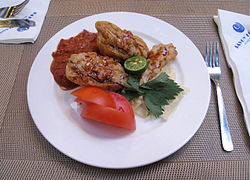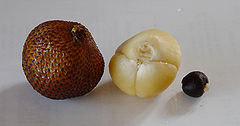Pempek, Indonesian delicious food
Pempek, mpek-mpek or empek-empek is a savoury fishcake delicacy from Palembang, Indonesia, made of fish and tapioca. Pempek is served with yellow noodles and a dark, rich sweet and sour sauce called kuah cuka or kuah cuko (lit. vinegar sauce).
Pempek is the best-known of Palembang's dishes. Its origin is undoubtly Palembang, however the history behind the creation of this savoury dish is unclear. According to local tradition, around the 16th century there was an old Chinese immigrant who lived near the Musi river. He noticed an abundance of fish caught by the local fishermen. In the Sumatran tropical climate, before the invention of refrigeration technology, most of these unsold leftover fish decayed and were wasted. The indigenous people, however had limited knowledge and techniques for processing fish. During that period, most of the indigenous people simply grilled, fried or boiled their fish instead of adding other ingredients to make new dishes. The old Chinese man mixed in some tapioca and other spices, which he then sold around the village on his cart. The people referred to this old man as 'pek-apek, where apek is a Chinese slang word to call an old man. The food is known today as empek-empek or pempek.
Another theory suggests that pempek was a Palembang adaptation of Southern Chinese ngo hiang or kekkian (fish slice) as a surimi (魚漿, yújiāng) based food. But instead of being served in soup or plainly fried, pempek is notable for its spicy palm sugar-vinegar based sauce.
Read User's Comments(0)
08.46 |
Label:
appetizers
Bandung is known as the tour kulinernya have a lot of food typical of the trail by the tourists when visiting this city. What is the food associated with Bandung?
Peuyeum tape or cassava is a food typical of West Java have a sweet taste, a little bit of acid and alcohol. Food is made from cassava through the fermentation process.
Food is similar to the tape but peuyeum dry form compared with the tape a little bit wet.
This is due to the production and storage peuyeum the swing.
Peuyeum the quality is good and smell fragrant, tasty, sweet, sweet, not sour. To produce a good peuyeum required yeast is good also. Sour taste in peuyeum often happens, this is due to the ongoing process of fermentation will sour.
Tongseng, The Original Indonesian Food
Tongseng is goat meat or beef stew dishes in curry-like soup with vegetables and kecap manis (sweet soy sauce). Originally from Surakarta in Indonesian province of Central Java.
The soup is made of ground mixture of garlic, shallot, black pepper, ginger, coriander, galangal, salam (bay leaves), and lemongrass sauteed with oil until it gets aromatic. The diced meat then poured into the sauteed mixture until cooked. Add water until it boiled and add sweet soy sauce with tamarind juice. After the boiled boiled reduces, add shredded cabbages and sliced tomato.
Tongseng is usually served with hot steamed rice. The soup of tongseng is similar to gulai soup, however gulai is without sweet soy sauce while tongseng always brownish gold because the addition of sweet soy sauce. Gulai is usually using cows offals while tongseng usually only uses meat (goat, mutton or beef).
Bandrek, Healty beverages from Indonesia
Bandrek is a traditional hot, sweet and spicy beverage native to Sundanese of West Java, Indonesia. The Sundanese people who live in the highland cool climate prefer to consume bandrek to warm themselves at night and during cold weather. This beverage is usually made of jahe(ginger), and other ingredients such as kayu manis (cinnamon), star anise, cloves, coriander seeds, cardamom pods, lemongrass, gula merah(palm sugar), and sometimes a small amount of chillies. Milk can be added or not, depending on one’s taste. Sweetened condensed milk or coconut milk is commonly used, and sometimes pieces of young coconut flesh are added as well. It is believed that bandrek has a healing effect on minor health problems, such as sore throat.
Batagor,
08.40 |
Label:
Main Course
Batagor (abbreviation from: Bakso Tahu Goreng, Sundanese and Indonesian: "fried bakso and tofu") is Sundanese Indonesian fried fishdumplings served with peanut sauce. It is traditionally made from tenggiri (wahoo) fish meat. Sometimes other types of seafood such as tuna,mackerel, and prawn also can be used to make batagor. Just like siomay, other complements to batagor are steamed cabbage, potatoes, bitter gourd and tofu. Batagor is cut into bite size pieces and topped with peanut sauce, sweet soy sauce, chili sauce and a dash of lime juice. Because being fried, batagor have crispy and crunchy texture. Since the serving method is identical, today batagor and siomay often sold under one vendor, with batagor offered as variation or addition to siomay.
Rendang, top delicious food in the World
08.37 |
Label:
Main Course
Rendang is a spicy meat dish which originated from the Minangkabau ethnic group of Indonesia, and is now commonly served across the country. One of the characteristic foods of Minangkabau culture, it is served at ceremonial occasions and to honour guests. Also popular in Malaysia, Singapore, Brunei, the southern Philippines and southern Thailand, rendang is traditionally prepared by the Indonesian community during festive occasions. Culinary experts often describe rendang as: 'West Sumatra caramelized beef curry'. In 2011 an online poll by 35,000 people held by CNN International chose Rendang as the number one dish of their 'World’s 50 Most Delicious Foods' list.
Rendang is rich in spices. Along with the main meat ingredient, rendang uses coconut milk (Minangkabau: karambia) and a paste of mixed ground spices, which includes ginger, galangal, turmeric leaves, lemon grass, garlic, shallot, chillies and other spices. This spice mixture is calledpemasak in Minangkabau. The spices garlic, shallot, ginger and galangal used in rendang have antimicrobial properties and serve as natural organic preservatives. If cooked properly, dry rendang can last for as long as four weeks.
Traditional Padang rendang takes hours to cook (usually four hours). Cooking rendang is time-consuming and requires patience. The meat pieces are slowly cooked in coconut milk and spices at precisely the right temperature until almost all the liquid is gone, allowing the meat to absorb the condiments. The cooking process changes from boiling to frying as the liquid evaporates. The slow cooking process allows the meat to absorb all the spices and to become tender. During the process, the meat should be slowly and carefully stirred in the spicy coconut milk mixture and turned over without burning or ruining the meat — well until all the liquids have evaporated. Because of its generous use of numerous spices, rendang is known for having a complex and unique taste.
Rendang is often served with steamed rice, ketupat (a compressed rice cake), or lemang (glutinous rice barbecued in bamboo tubes), accompanied with vegetable side dishes such as boiledcassava leaf, cubadak[9] (young jackfruit gulai), cabbage gulai, and lado (red or green chilli pepper sambal).
Salak
Salak (Salacca zalacca) is a species of palm tree (family Arecaceae) native to Indonesia, Brunei and Malaysia. It is a very short-stemmed palm, with leaves up to 6 metres (20 ft) long; each leaf has a 2-metre long petiole with spines up to 15 centimetres (5.9 in) long, and numerous leaflets.
The fruit grow in clusters at the base of the palm, and are also known as snake fruit due to the reddish-brown scaly skin. They are about the size and shape of a ripe fig, with a distinct tip. The pulp is edible. The fruit can be peeled by pinching the tip, which should cause the skin to slough off so it can be pulled away. The fruit inside consists of three lobes with the largest of the three containing a large inedible seed. The lobes resemble, and have the consistency of, large peeled garlic cloves. The taste is usually sweet and acidic, but its apple-like texture can vary from very dry and crumbly (salak pondoh from Yogyakarta) to moist and crunchy (salak Bali).
Langganan:
Postingan (Atom)








